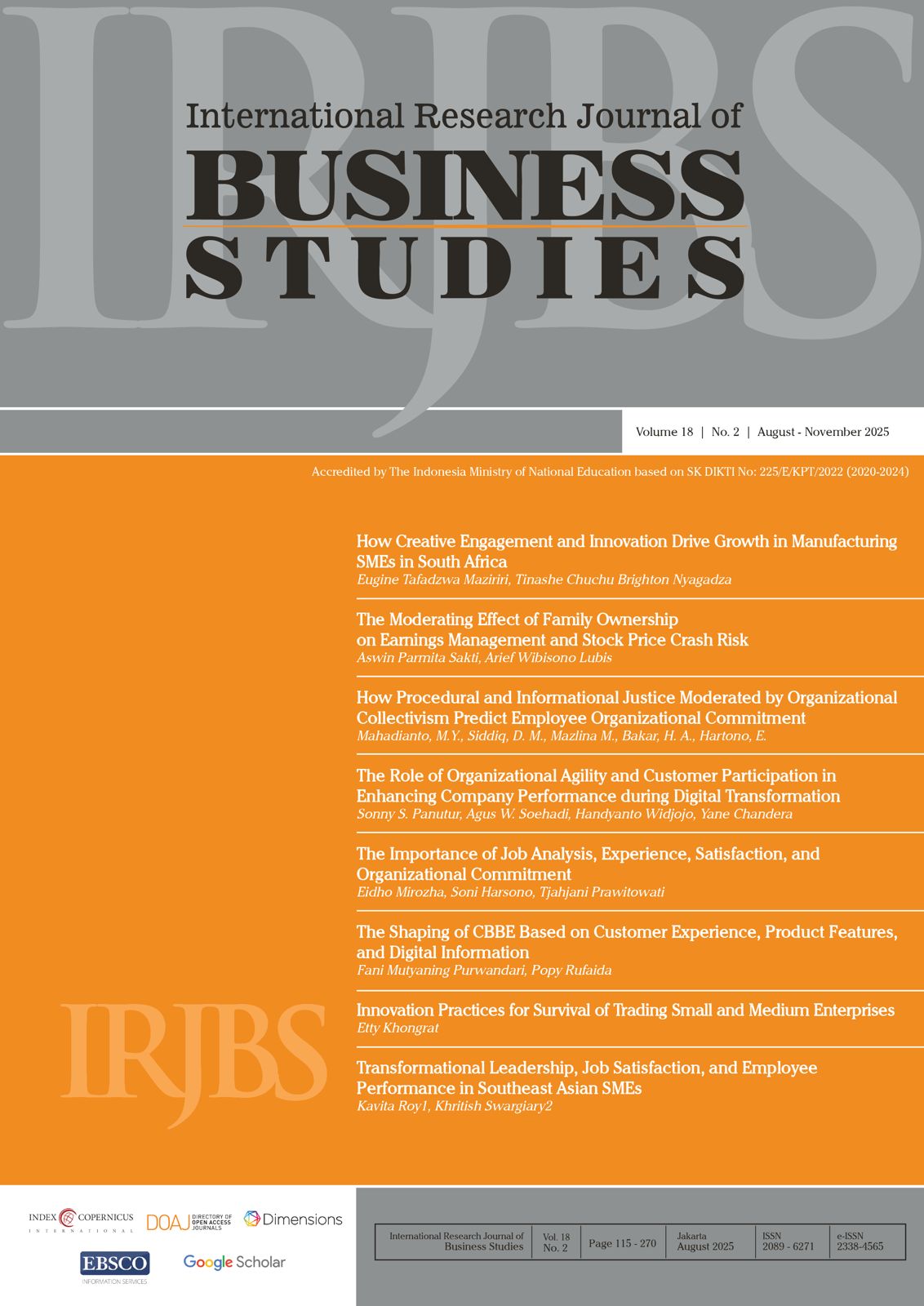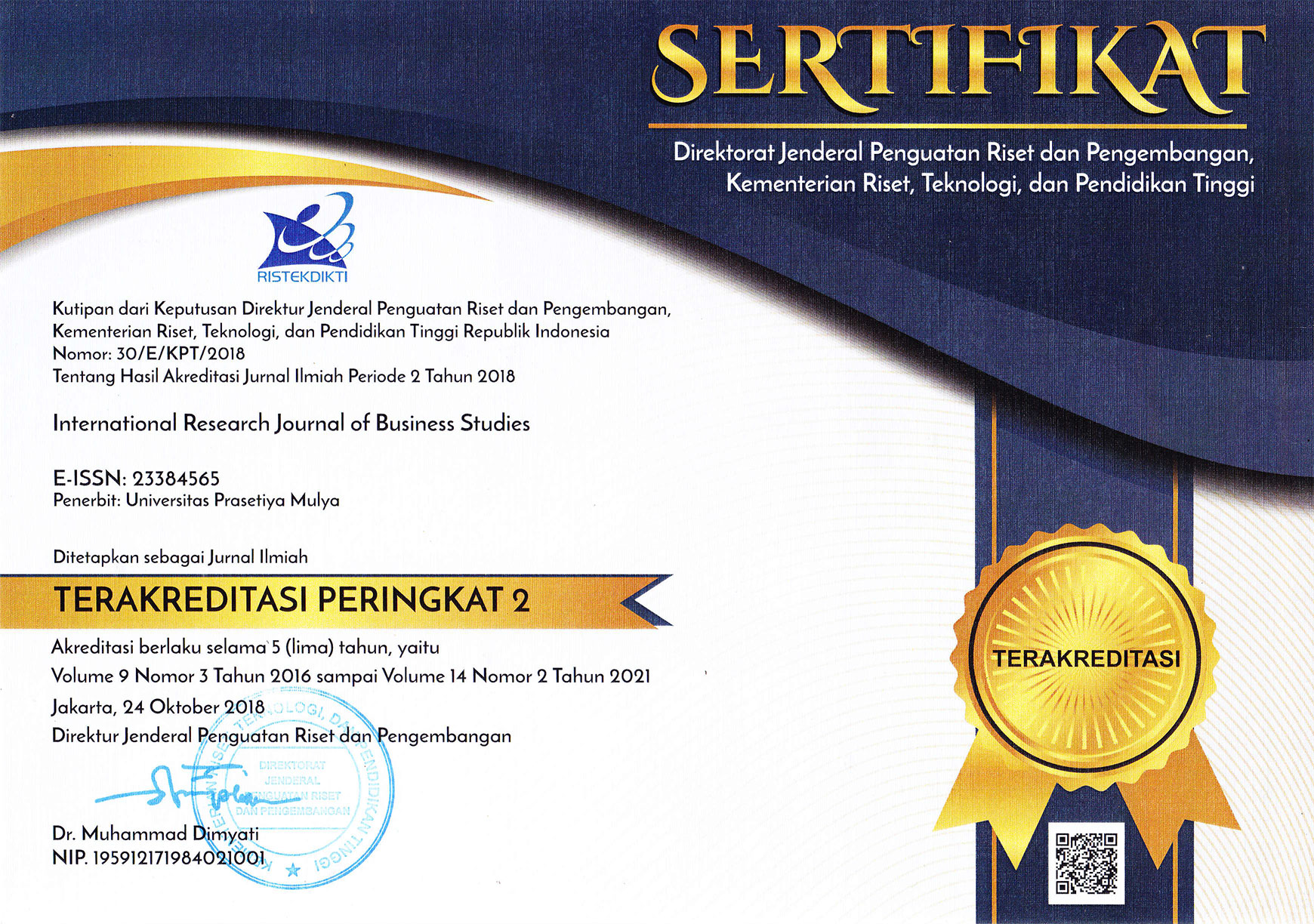The Moderating Effect of Family Ownership on Earnings Management and Stock Price Crash Risk
DOI:
https://doi.org/10.21632/irjbs.18.2.139-158Keywords:
earnings management, stock price crash risk, family ownership, GMMAbstract
This study examines the influence of earnings management on stock price crash risk within publicly listed companies in Indonesia. Additionally, it explores the moderating role of family ownership in this relationship, assessing whether it strengthens or weakens the connection between earnings management and stock price crash risk. The research employs an unbalanced panel data regression framework, utilizing dynamic panel data estimation through the system-GMM approach. Empirical findings indicate that accrual-based earnings management significantly increases the likelihood of stock price collapse, whereas real earnings management exerts only a marginal positive effect on crash risk. Furthermore, results suggest that family ownership amplifies the impact of earnings management on stock price crash risk, implying that firms with family ownership engage in more aggressive earnings manipulation practices, which in turn heighten the probability of future stock price crashes.
References
Aiken, L. S., & West, S. G. (1991). Multiple regression: Testing and interpreting interactions. In Multiple regression: Testing and interpreting interactions. Sage Publications, Inc.
Andres, C. (2008). Large shareholders and firm performance-An empirical examination of founding-family ownership. Journal of Corporate Finance, 14(4), 431–445. https://doi.org/10.1016/j.jcorpfin.2008.05.003
Ball, R., & Brown, P. (1968). An Empirical Evaluation of Accounting Income Numbers. In Source: Journal of Accounting Research (Vol. 6, Issue 2). Autumn.
Bhutto, N. A., Shaique, M., Kanwal, S., Matlani, A., & Zahid, H. (2021). Impact of Earnings Management Practices on Stock Return. Indonesian Capital Market Review, 13(1). https://doi.org/10.21002/icmr.v13i1.12839
Chen, C., Kim, J. B., & Yao, L. (2017). Earnings smoothing: Does it exacerbate or constrain stock price crash risk? Journal of Corporate Finance, 42, 36–54. https://doi.org/10.1016/j.jcorpfin.2016.11.004
Chen, J., Hong, H., Stein, J. C., Campbell, J., Daniel, K., Froot, K., Jagannathan, R., Jorion, P., & Lamoreaux, C. (2001). Forecasting crashes: trading volume, past returns, and conditional skewness in stock prices $. In Journal of Financial Economics (Vol. 61).
Claessens, S., Djankov, S., Fan, J. P. H., & Lang, L. H. P. (2002). Disentangling the Incentive and Entrenchment Effects of Large Shareholdings. In Source: The Journal of Finance (Vol. 57, Issue 6).
Claessens, Stijn., Fan, J. P. H. ., & Lang, L. H. P. . (2002). The benefits and costs of group affiliation : evidence from East Asia. United Nations University, World Institute for Development Economics Research.
Cohen, D. A., & Zarowin, P. (2010). Accrual-based and real earnings management activities around seasoned equity offerings. Journal of Accounting and Economics, 50(1), 2–19. https://doi.org/https://doi.org/10.1016/j.jacceco.2010.01.002
Cohen, J., Cohen, P., West, S. G., & Aiken, L. S. (2003). Applied multiple regression/correlation analysis for the behavioral sciences, 3rd ed. In Applied multiple regression/correlation analysis for the behavioral sciences, 3rd ed. Lawrence Erlbaum Associates Publishers.
Dechow, P. M., Kothari, S. P., Watts, R. L., & Simon, W. E. (1998). The relation between earnings and cash flows. In Journal of Accounting and Economics (Vol. 25).
Dechow, P. M., Sloan, R. G., & Sweeney, A. P. (1995). Detecting Earnings Management. In Source: The Accounting Review (Vol. 70, Issue 2).
DeFond, M. L., Hung, M., Li, S., & Li, Y. (2015). Does mandatory IFRS adoption affect crash risk? The Accounting Review, 90(1), 265–299.
Edmans, A. (2013). BLOCKHOLDERS AND CORPORATE GOVERNANCE. http://www.nber.org/papers/w19573
Faccio, M., Lang, L. H. P., Bigelli, M., Caprio, L., Ginglinger, E., Khanna, A., Mcconnell, J., Mengoli, S., Pye, R., Roberts, G., & Schwert, B. (2002). The ultimate ownership of Western European corporations $ We are grateful to. In Journal of Financial Economics (Vol. 65).
Fatima, H., Haque, A., & Usman, M. (2020). Is there any association between real earnings management and crash risk of stock price during uncertainty? An evidence from family-owned firms in an emerging economy. Future Business Journal, 6(1). https://doi.org/10.1186/s43093-020-00038-5
Ge, W., & Kim, J. B. (2014). Real earnings management and the cost of new corporate bonds. Journal of Business Research, 67(4), 641–647. https://doi.org/10.1016/j.jbusres.2013.01.021
Haider, Jahanzaib, Qayyum, Abdul, & Zainudin, Zalina. (2021). Are Family Firms More Levered? An Analysis of Family and Non-Family Firms. SAGE Open, 11(2), 21582440211022320. https://doi.org/10.1177/21582440211022322
Helling, A. R., Maury, B., & Liljeblom, E. (2019). Exit as governance: Do blockholders affect corporate innovation in large US firms?
Hribar, P., Collins, D. W., & Collinst, D. W. (2002). Errors in Estimating Accruals: Implications for Empirical Research. In Source: Journal of Accounting Research (Vol. 40, Issue 1).
Hsu, C., Wang, R., & Whipple, B. C. (2022). Non-GAAP earnings and stock price crash risk. Journal of Accounting and Economics, 73(2–3). https://doi.org/10.1016/j.jacceco.2021.101473
Hutton, A. P., Marcus, A. J., & Tehranian, H. (2009). Opaque financial reports, R2, and crash risk. Journal of Financial Economics, 94(1), 67–86. https://doi.org/https://doi.org/10.1016/j.jfineco.2008.10.003
Khalil, M., Harianto, S., & Guney, Y. (2022). Do political connections reduce earnings management? Review of Quantitative Finance and Accounting, 59(1), 273–310. https://doi.org/10.1007/s11156-022-01062-y
Kim, J. B., Li, Y., & Zhang, L. (2011). Corporate tax avoidance and stock price crash risk: Firm-level analysis. Journal of Financial Economics, 100(3), 639–662. https://doi.org/10.1016/j.jfineco.2010.07.007
Kothari, S. P., Leone, A. J., & Wasley, C. E. (2005). Performance matched discretionary accrual measures. Journal of Accounting and Economics, 39(1), 163–197. https://doi.org/10.1016/j.jacceco.2004.11.002
Kripfganz, S. (2019). Generalized method of moments estimation of linear dynamic panel-data models. http://www.kripfganz.de/stata/
La Porta, R., Lopez-De-Silanes, F., & Shleifer, A. (1999). Corporate Ownership around the World. In Source: The Journal of Finance (Vol. 54, Issue 2).
Leuz, C., Nanda, D., & Wysocki, P. D. (2003). Earnings management and investor protection: An international comparison. Journal of Financial Economics, 69(3), 505–527. https://doi.org/10.1016/S0304-405X(03)00121-1
Loureiro, G., & Silva, S. (2022). Earnings management and stock price crashes post U.S. cross-delistings. International Review of Financial Analysis, 82. https://doi.org/10.1016/j.irfa.2022.102215
Maury, B. (2006). Family ownership and firm performance: Empirical evidence from Western European corporations. Journal of Corporate Finance, 12(2), 321–341. https://doi.org/https://doi.org/10.1016/j.jcorpfin.2005.02.002
Nguyen, Q., Kim, M. H., & Ali, S. (2024). Corporate governance and earnings management: Evidence from Vietnamese listed firms. International Review of Economics and Finance, 89, 775–801. https://doi.org/10.1016/j.iref.2023.07.084
Octaviani, F. A., & Utama, C. A. (2022). Impact of Corporate Hedging and ESG on Stock Price Crash Risk: Evidence from Indonesian Energy Firms. Indian Journal of Corporate Governance, 15(2), 149–169. https://doi.org/10.1177/09746862221129341
Ren, X., Zhong, Y., Cheng, X., Yan, C., & Gozgor, G. (2023). Does carbon price uncertainty affect stock price crash risk? Evidence from China. Energy Economics, 122, 106689. https://doi.org/https://doi.org/10.1016/j.eneco.2023.106689
Roodman, D. (2009). How to do Xtabond2: An Introduction to Difference and System GMM in Stata. The Stata Journal, 9(1), 86–136. https://doi.org/10.1177/1536867X0900900106
Roychowdhury, S. (2006). Earnings management through real activities manipulation. Journal of Accounting and Economics, 42(3), 335–370. https://doi.org/10.1016/j.jacceco.2006.01.002
Ryu, H.-Y., & Chae, S.-J. (2019). Family Firms and Stock Price Crash Risk. The Institute of Management and Economy Research, 10(4), 77–86. https://doi.org/10.32599/apjb.10.4.201912.77
Sandria, F. (2021, July 27). Deretan Skandal Lapkeu di Pasar Saham RI, Indofarma-Hanson! https://www.cnbcindonesia.com/market/20210726191301-17-263827/deretan-skandal-lapkeu-di-pasar-saham-ri-indofarma-hanson?page=all.
Shyu, J. (2011). Family ownership and firm performance: Evidence from Taiwanese firms. International Journal of Managerial Finance, 7, 397–411. https://doi.org/10.1108/17439131111166393
Srinidhi, B., & Liao, Q. (2020). Family firms and crash risk: Alignment and entrenchment effects. Journal of Contemporary Accounting and Economics, 16(2). https://doi.org/10.1016/j.jcae.2020.100204
Thomsen, S., & Pedersen, T. (2000). Ownership Structure and Economic Performance in the Largest European Companies. In Management Journal (Vol. 21, Issue 6). https://about.jstor.org/terms
Utama, C. A., Utama, S., & Amarullah, F. (2017). Corporate governance and ownership structure: Indonesia evidence. Corporate Governance (Bingley), 17(2), 165–191. https://doi.org/10.1108/CG-12-2015-0171
Yang, M., Wang, Y., Bai, L., & Maresova, P. (2023). Corporate social responsibility, family involvement, and stock price crash risk. Corporate Social Responsibility and Environmental Management, 30(3), 1204–1225. https://doi.org/10.1002/csr.2414
Zachro, S. F., & Utama, C. A. (2021). The Effect of Family Ownership on the Relationship between Busy Directors and Stock Price Crash Risk for Listed Firms on the Indonesia Stock Exchange. Jurnal Keuangan Dan Perbankan, 25(1). https://doi.org/10.26905/jkdp.v25i1.4909
Downloads
Submitted
Accepted
Published
How to Cite
Issue
Section
Categories
License
Copyright (c) 2025 Aswin Parmita Sakti, Arief Wibisono Lubis (Author)

This work is licensed under a Creative Commons Attribution-ShareAlike 4.0 International License.
Journal Author(s) Rights
For IRJBS to publish and disseminate research articles, we need publishing rights (transferred from the author(s) to the publisher). This is determined by a publishing agreement between the Author(s) and IRJBS. This agreement deals with the transfer or license of the copyright of publishing to IRJBS, while Authors still retain significant rights to use and share their own published articles. IRJBS supports the need for authors to share, disseminate and maximize the impact of their research and these rights, in any databases.
As a journal Author, you have rights to many uses of your article, including use by your employing institute or company. These Author rights can be exercised without the need to obtain specific permission. Authors publishing in IRJBS journals have comprehensive rights to use their works for teaching and scholarly purposes without needing to seek permission, including:
- use for classroom teaching by Author or Author's institution and presentation at a meeting or conference and distributing copies to attendees;
- use for internal training by the author's company;
- distribution to colleagues for their research use;
- use in a subsequent compilation of the author's works;
- inclusion in a thesis or dissertation;
- reuse of portions or extracts from the article in other works (with full acknowledgment of the final article);
- preparation of derivative works (other than commercial purposes) (with full acknowledgment of the final article);
- voluntary posting on open websites operated by the author or the author’s institution for scholarly purposes,
(But it should follow the open access license of Creative Common CC-by-SA License).
Authors/Readers/Third Parties can copy and redistribute the material in any medium or format, as well as remix, transform, and build upon the material for any purpose, even commercially. Still, they must give appropriate credit (the name of the creator and attribution parties (authors' detail information), a copyright notice, an open access license notice, a disclaimer notice, and a link to the material), provide a link to the license, and indicate if changes were made (Publisher indicates the modification of the material (if any) and retain an indication of previous modifications.
Authors/Readers/Third Parties can read, print and download, redistribute or republish the article (e.g. display in a repository), translate the article, download for text and data mining purposes, reuse portions or extracts from the article in other works, sell or re-use for commercial purposes, remix, transform, or build upon the material, they must distribute their contributions under the same license as the original Creative Commons Attribution-ShareAlike (CC BY-SA).
This work is licensed under a Creative Commons Attribution-ShareAlike 4.0 International License.








